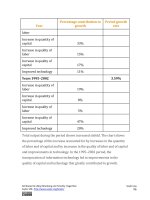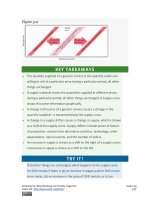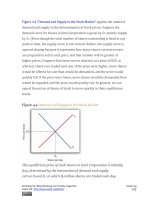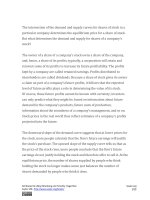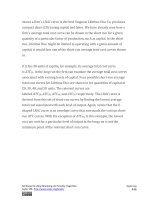Authors libby rittenberg 890
Bạn đang xem bản rút gọn của tài liệu. Xem và tải ngay bản đầy đủ của tài liệu tại đây (525.63 KB, 1 trang )
Figure 17.2 "Measuring Opportunity Cost in Roadway" shows the
opportunity cost of producing boats at points A, B, and C. Recall that the
slope of a curve at any point is equal to the slope of a line drawn tangent to
the curve at that point. The slope of a line tangent to the production
possibilities curve at point B, for example, is −1. The opportunity cost of
producing one more boat is thus one truck. As the law of increasing
opportunity costs predicts, in order to produce more boats, Roadway must
give up more and more trucks for each additional boat. Roadway’s
opportunity cost of producing boats increases as we travel down and to
the right on its production possibilities curve.
Comparative Advantage
People participate in international trade because they make themselves
better off by doing so. In this section we will find that countries that
participate in international trade are able to consume more of all goods
and services than they could consume while producing in isolation from
the rest of the world.
Suppose the world consists of two countries, Roadway and Seaside. Their
production possibilities curves are given in Figure 17.3 "Comparative
Advantage in Roadway and Seaside". Roadway’s production possibilities
curve in Panel (a) is the same as the one in Figure 17.1 "Roadway’s
Production Possibilities Curve" and Figure 17.2 "Measuring Opportunity
Cost in Roadway". Seaside’s curve is given in Panel (b).
Attributed to Libby Rittenberg and Timothy Tregarthen
Saylor URL: />
Saylor.org
890
